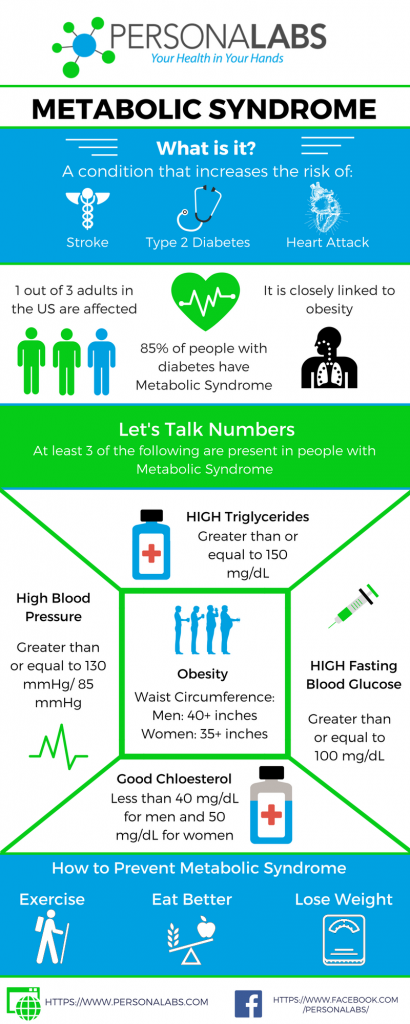- Fast results
- 4,000+ locations
- 4.8 star rating
Need Help? (888) GET LABS


Do you know your Metabolic Syndrome Score? If you don’t — here’s why you need to know this key health indicator.
Metabolic syndrome occurs most frequently in people who are overweight. People with metabolic syndrome typically have three or more related health conditions that increase their chances of developing one or more costly “killer diseases” such as cancer, diabetes, heart disease, kidney disease, liver disease and lung disease.

According to the National Institutes of Health, there are five risk factors that increase the likelihood that a person will become chronically ill with a “killer disease”. People who test positive for three or more of these risk factors are deemed to have “metabolic syndrome.” The number of Americans testing positive for metabolic syndrome has been increasing at an alarming rate in recent years.
Lifestyle choices and habits are the major drivers of metabolic syndrome, with insufficient physical activity and poor nutrition at the forefront. The typical American gets less than the recommended levels of daily exercise and regularly eats foods that are high in calories, sugar, salt and hydrogenated oils – leading them to become overweight and triggering a cascade of troublesome long-term health conditions that are expensive to treat and manage.
The rising number of Americans suffering from chronic lifestyle diseases is creating a crisis in the American healthcare system … and creating financial distress for individuals who cannot afford to pay the out-of-pocket costs for expensive medical treatments not covered by their health insurance.
If your blood tests show that you have three or more of the following risk factors, it’s a clear sign that you have metabolic syndrome. People with metabolic syndrome should take immediate action to change their lifestyle habits in order to save themselves the heartache and expense of a chronic and costly health condition.

The location of your weight has a greater impact on your risk for lifestyle diseases than your total body weight. The waistline measurement is an indicator of where your weight is carried. Individuals who carry their weight around their waist have a higher risk for lifestyle disease than those that carry their weight around their hips. For men, a waistline measuring 40 inches or more, and for women a waistline measuring 35 inches or more, is a risk factor.
HDL Cholesterol is known as the “good” cholesterol for its function of “cleaning up” the cholesterol in our bodies. When your levels of HDL cholesterol are low, you are at higher risk of developing cardiovascular disease and heart disease. In men, an HDL level less than 40mg/dL and in women an HDL level less than 50 mg/dL puts you at risk.
Triglycerides are a kind of fat found in the blood and are the most common type of fat in the body. Triglycerides are stored in tissues (fat cells), but are also transported through the bloodstream. High levels of triglyceride in your blood indicate that your body is not utilizing fats properly. Excessive blood triglycerides increase the risk of heart disease and cardiovascular disease.
Carbohydrates and sugars are broken down during digestion to simple sugars glucose and fructose, which are transported to tissues through the bloodstream. High fasting blood sugar (blood glucose) levels indicate that there is a problem with the way your body reacts to sugar (diabetes). A blood sugar level of 100 mg/dL or higher can be an early indication of insulin resistance and/or diabetes.
When the heart pumps, it puts pressure on the blood which, in turn, puts pressure on your artery walls. A consistent blood pressure measurement of 130/85 or higher can not only damage your heart, it can also lead to harmful plaque buildup and reduced blood flow from the heart to the body. Untreated high blood pressure puts you at risk for long-term damage to blood vessels and risk for heart attack, stroke, heart failure, sexual dysfunction, vision loss, and kidney dis-ease/failure.
The Personalabs Health Snapshot is a simple and affordable test that will reveal your Metabolic Syndrome score and whether you are at high, medium or low risk of getting cancer, diabetes, heart disease or other costly lifestyle diseases.
The best things you can do to maintain your health and reduce your risk of developing diabetes, heart disease, or experiencing a debilitating stroke are:
Personalabs is dedicated to putting control of your healthcare in your hands, with affordable direct access to the lab tests you need, telephone or video consultations with one of our on-call physicians, and prescription services for oral contraceptives, STDs/STIs, erectile dysfunction, urinary tract infections, and balding.

© Copyright 2025 Personalabs. All Rights Reserved.